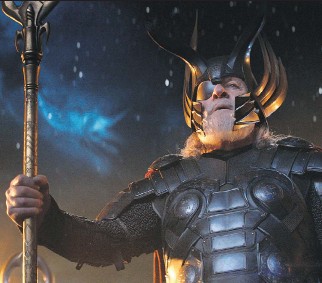Unless, of course, the author of the book in question is Neil Gaiman. Gaiman well deserves his status as one of a handful of authors who could publish literally anything and a few hundred thousand people would rush out and buy it. Partly, that’s because Gaiman is a brilliant writer and performs wonders with archetypes. In Norse Mythology, he takes characters that are twodimensional in myth (Odin is wise but cruel, Loki is tricky but sadistic, Thor is bellicose but dim-witted) and makes them complex and captivating. Mostly though, it’s because Gaiman has built a fiercely loyal following, as willing to read a book about a boy raised by ghosts (The Graveyard Book) as one about a magical London beneath the streets of the mundane one (Neverwhere).
There are political undertones in Norse Mythology if you want them. Odin builds a wall to protect Asgard (well, actually it’s built by a giant, whom Thor kills once the work is largely done).
But for the most part these stories hold remarkably true to ancient texts such as the Volospa, the Prose Edda, and the Volsunga Saga. This book’s more modern ancestor is Roger Lancelyn Green’s 1960 collection Myths of the Norsemen (which Gaiman read as a child), and both Green and Gaiman trace the Norse myths from the beginning of the world to Ragnorak, the final battle that ends the world.
Green was a member of the Oxford literary group the Inklings, whose other members include C.S. Lewis and J.R.R. Tolkien. In many ways Norse Mythology plays a similar role in understanding the Gaiman canon as the Silmarillion does in understanding Tolkien’s The Lord of the Rings universe. The Norse gods are everywhere in Gaiman’s other works: one of the key characters in American Gods (which will première as a television show on Starz in April) is a god named Mr. Wednesday, who, it is quickly revealed, is actually Odin. Loki appears several times in the Sandman graphic novels, often while trying to trick Odin and Thor. Core themes that animate many of Gaiman’s stories are present in these myths. For instance, Gaiman likes to write about parallel worlds, with particular focus on the edges where the magical seeps into the mundane. In Norse Mythology the nine worlds are connected by Yggdrasil, the world-tree, and the gods flit between them with relative ease. In Gaiman’s other books the portals are more commonplace — e.g. bricked up doors, sewer grates, a wall on the edge of town — but the fascination with hopping between worlds is always there. Many of his characters seem modelled from gods in Norse myth: they are flawed, self-interested and wholly relatable.
Norse Mythology itself is 15 distinct stories covering everything from how Thor got his hammer (Loki tricked some dwarfs into making it) to how Fenrir, the wolf who will swallow the world, learned to hate the gods (they shackled him up, laughed when he couldn’t escape, then left him to rot). Gaiman adds some subtle modern twists to the stories, such as a feminist undertone in the depiction of goddesses as more autonomous and powerful compared with their typical role of overly sexualized bit-players. On several occasions gods try to marry Freya off without asking her first: At one point Thor’s hammer is stolen and he agrees to marry her to the thief in exchange for its safe return. When Freya finds out she says: “Do you think I’m that foolish? That disposable? That I’m someone who would actually marry an ogre just to get you out of trouble?” In another story Hymir, the mighty king of the giants who owns a cauldron three miles deep, is easily controlled by his wife. Despite his bombast she brings him up short with sardonic comments like “Are you finished breaking things?”
There are limits, though, in that most of the stories focus on Thor or Loki, and female characters are typically mentioned in relation to a male protagonist (e.g. wife, daughter, sister). This is the reality of the surviving myths, as many that focused on female gods were lost and those that did survive tend not to feature them. There are broader flaws in the myths as well, which we tend to accept as an inheritance.
It is unclear why Odin, who knows that Fenrir will try to destroy the world, simply chains him instead of killing him. It is unclear why Loki, typically several steps ahead when other gods try to trap him, turns himself into a salmon and waits nearby, resulting in his capture and imprisonment. These oddities, though bothersome, are possibly explained by parts of stories lost to time and certainly no failing of Gaiman’s. Ultimately, this is a careful and rather lovely retelling of stories that have underpinned Western literature since at least the 13th century. The prose is lively, the details are vivid, and the characters — well, there’s a reason we’re still retelling their stories after 800 years.
In Norse Mythology, he takes characters that are two dimensional in myth and makes them complex and captivating.

